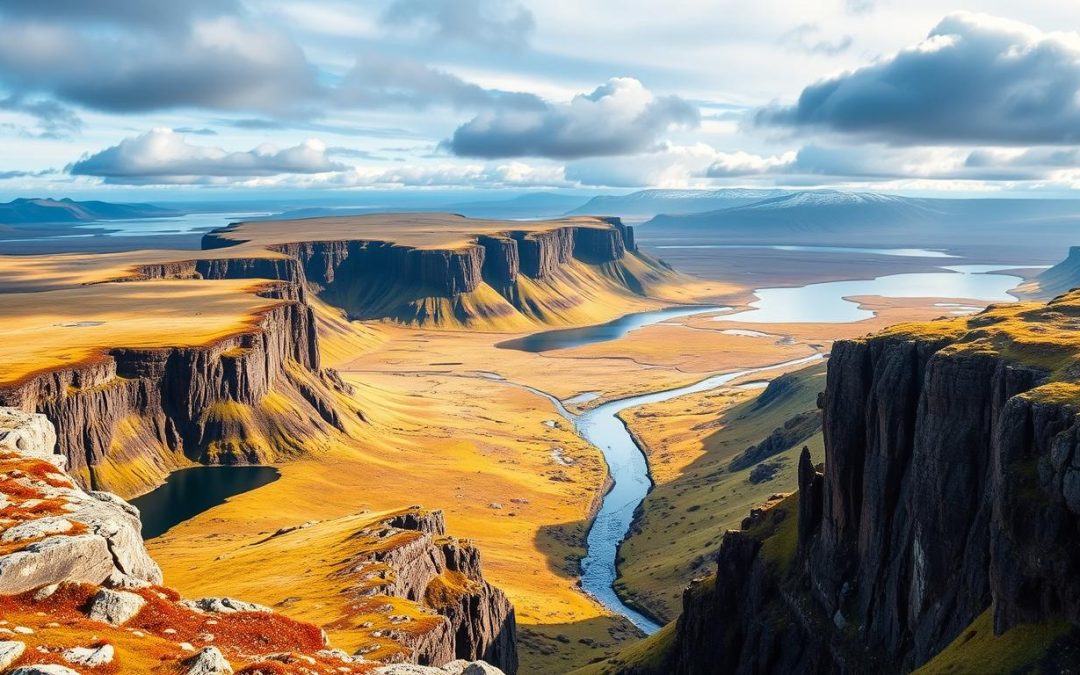Have you ever wondered what it’s like to stand between two continents? At Þingvellir National Park, you can do just that. This UNESCO World Heritage site is not only a geological marvel but also a cornerstone of Icelandic history.
Located just a short drive from Reykjavík, this park is where the Eurasian and North American tectonic plates visibly pull apart. The dramatic rift valleys and crystal-clear waters of Silfra make it a must-see destination. But it’s not just about the landscapes—this is where Iceland’s first parliament, the Alþingi, was established over a thousand years ago.
Whether you’re a history buff, a nature lover, or an adventure seeker, there’s something here for everyone. From hiking trails to snorkeling in Silfra, this guide will help you make the most of your visit. Ready to explore? Let’s dive in!
Key Takeaways
- Stand between two tectonic plates at this unique geological site.
- Discover the birthplace of Iceland’s parliament, the Alþingi.
- Snorkel in the crystal-clear waters of Silfra.
- Explore dramatic rift valleys and scenic hiking trails.
- Learn about the park’s rich history and cultural significance.
Exploring the History and Geology of Þingellir National Park
What if you could walk through a place where history and geology collide? Þingvellir is that rare destination where the past and the Earth’s movements come alive. From its role as the birthplace of Iceland’s first parliament to its dramatic geological features, this site offers a unique blend of culture and nature.
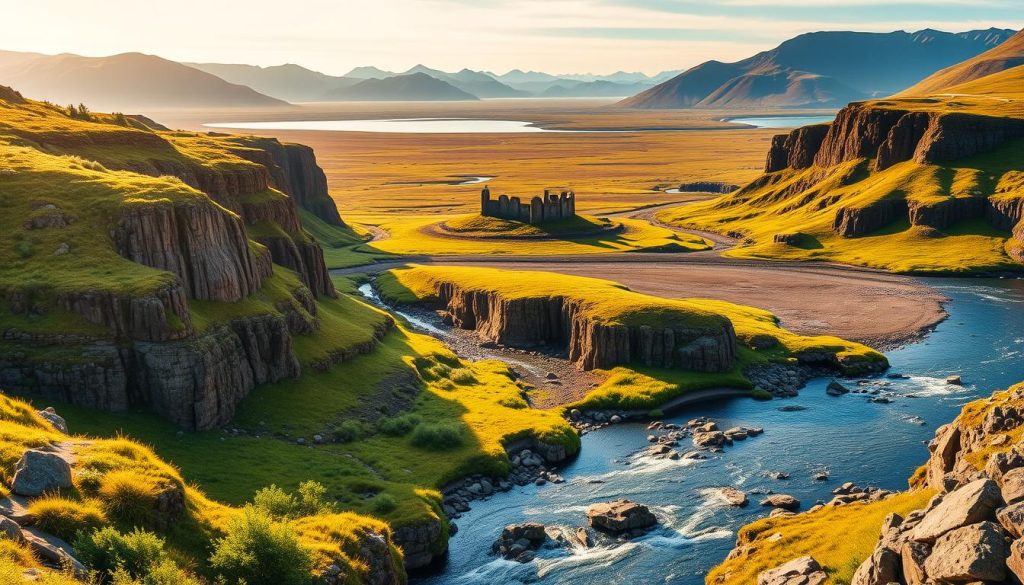
Historic Significance and the Old Commonwealth
Þingvellir holds a special place in Iceland’s history. It was here, in 930 AD, that the AlÞingi—the world’s oldest parliamentary assembly—was established. For over 800 years, leaders gathered here to make laws and settle disputes. This marked the beginning of the Old Commonwealth, a period that shaped Iceland’s identity.
Walking through the site, you can almost feel the echoes of the past. The Lögberg, or Law Rock, was where laws were proclaimed, and decisions were made. It’s a powerful reminder of how this place shaped a nation.
Geological Marvels and Tectonic Plates
Beyond its history, Þingvellir is a geological wonder. It’s one of the few places on Earth where you can see the tectonic plates of Eurasia and North America pulling apart. Over time, this movement has created the stunning rift valley that defines the landscape.
The Almannagjá gorge is a prime example of this geological activity. Its towering cliffs and rugged terrain are a testament to the Earth’s dynamic forces. Nearby, the crystal-clear waters of Silfra Fissure offer a glimpse into the plate boundary below.
Whether you’re a history enthusiast or a geology buff, Þingvellir invites you to explore its fascinating stories and natural wonders. It’s a place where the past and the present collide, offering a truly unforgettable experience.
Þingellir National Park, Iceland: Best Things to Do – Top Picks
Ever dreamed of stepping into a place where nature and history intertwine? This UNESCO world heritage site offers a mix of breathtaking landscapes and cultural treasures. From dramatic rifts to serene waterfalls, every corner tells a story.
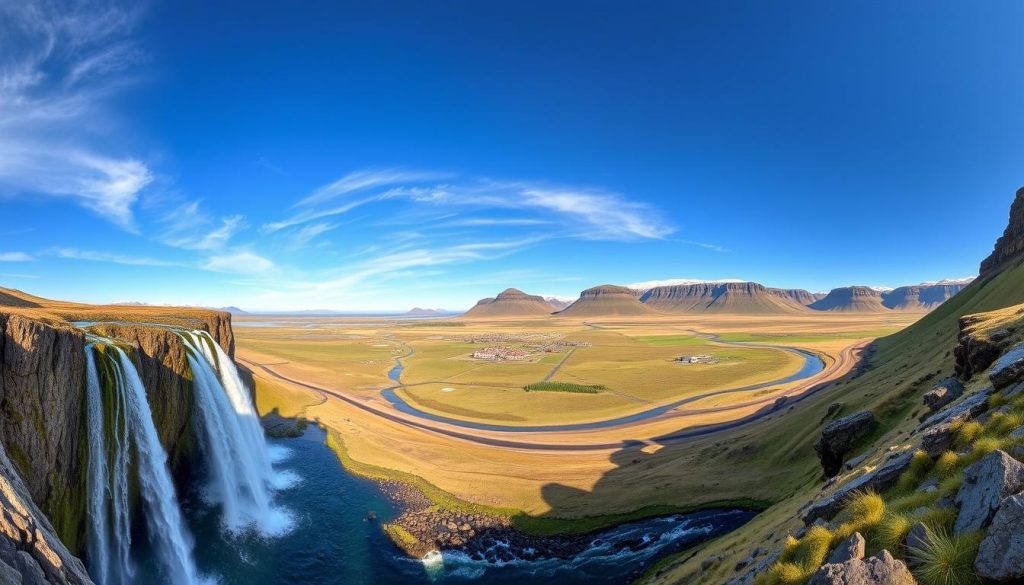
Top Attractions and Must-Do Experiences
Start your adventure at the Öxarárfoss waterfall. This stunning cascade is easily accessible and perfect for photos. Next, head to Silfra, where you can snorkel between the North American and Eurasian tectonic plates. The crystal-clear waters make it a once-in-a-lifetime experience.
Don’t miss the Hakið visitor center. Its interactive exhibits provide deeper insights into the park’s history and geology. For hikers, the rift valley trails offer panoramic views of the dramatic landscape.
Why This UNESCO Site Stands Out
What makes this site so special? It’s not just the natural beauty. The park’s UNESCO designation highlights its unique blend of cultural and geological significance. It’s a place where you can walk through history while witnessing the Earth’s incredible forces at work.
As part of the Golden Circle tour, this destination is a must-see. Whether you’re exploring the rift or learning about the Alþingi, every moment here is unforgettable. Ready to dive into an adventure like no other?
Guide to Navigating the Park: Visitor Centers and Trails
Ready to explore the park’s trails and visitor centers? Here’s how to navigate like a pro. Start your journey at the Hakið Visitor Center, where you’ll find interactive exhibits and detailed maps. This center is your gateway to understanding the park’s history and geology.
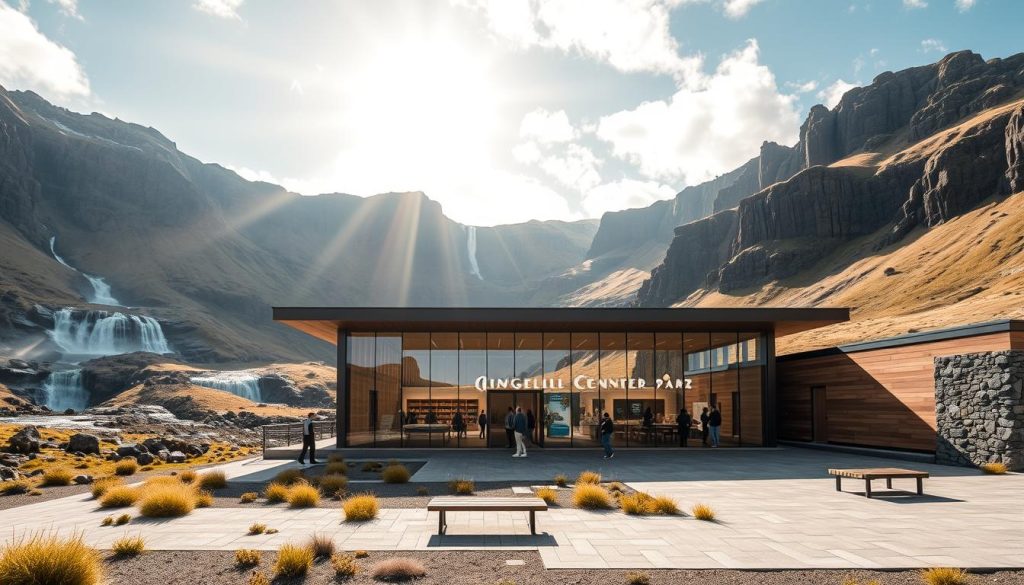
Discovering the Hakið Visitor Center
The Hakið Visitor Center is more than just a starting point. Its “Heart of Iceland” exhibit uses VR and touch screens to bring the park’s story to life. Admission is free for children under 18, making it a family-friendly stop. Spend time here to get oriented before hitting the trails.
Essential Trail Routes and Boardwalks
The park’s trail system is well-marked and easy to follow. Begin with the Almannagjá Trail, a short walk that takes you along the rift valley. For a longer adventure, try the Öxarárfoss Trail, which features boardwalks and stunning views of the waterfall.
Here’s a quick guide to the park’s main trails:
| Trail Name | Distance | Highlights |
|---|---|---|
| Almannagjá Trail | 0.5 miles (1 km) | Rift valley views |
| Öxarárfoss Trail | 5.5 miles (9 km) | Waterfall and boardwalks |
| Lögberg – Drekkingarhylur Trail | 1 mile (1.6 km) | Historical sites |
Parking is available in designated areas, with a small fee. Arrive early to secure a spot, especially during peak seasons. If you’re joining a tour, check with your guide for meeting points and schedules.
Don’t forget to read the informational signage along the trails. These signs provide fascinating insights into the park’s geology and history, enhancing your experience. With these tips, you’re all set to explore with confidence!
Adventurous Activities at Þingellir: Snorkeling, Diving, and Hiking
Looking for an unforgettable adventure in a place where nature and history collide? This UNESCO site offers thrilling activities that let you experience its unique landscapes up close. From snorkeling in crystal-clear waters to hiking along dramatic rift valleys, there’s something for every adventurer.
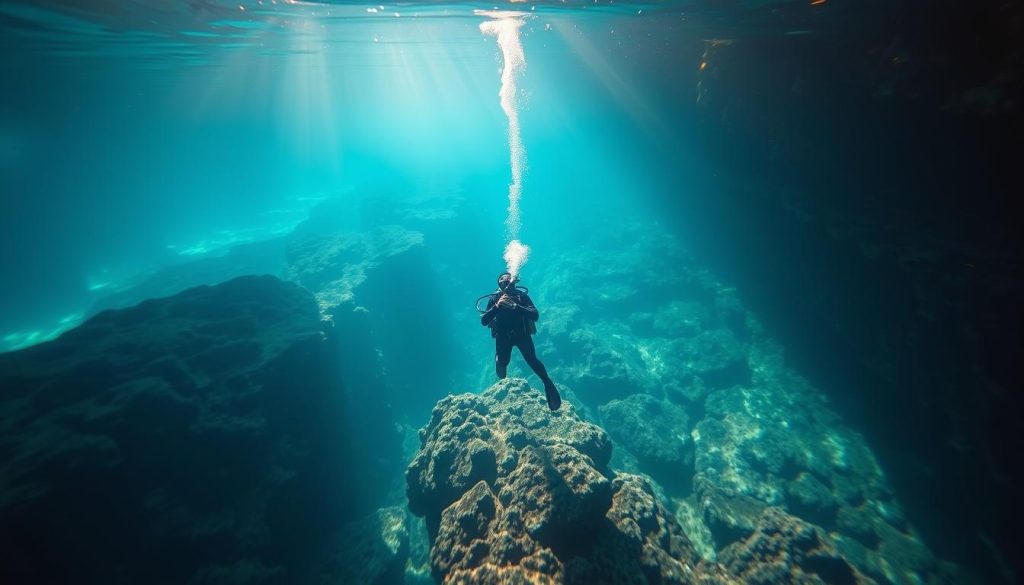
Exploring Silfra Fissure by Water
One of the most unique experiences here is snorkeling or diving in the Silfra Fissure. This underwater canyon lies between the tectonic plates of Eurasia and North America. The water is incredibly clear, offering visibility of up to 100 meters. It’s like floating between two continents!
For diving, you’ll need a drysuit and some experience. Snorkeling is more accessible, with guided tours providing all the necessary gear. Summer is the best time for these activities, as the weather is milder and the water more inviting.
Hiking Along Rugged Trails
If you prefer to stay on land, the park’s hiking trails are a must. The rift valley offers stunning views of the tectonic plates pulling apart. Trails like Almannagjá and Öxarárfoss are well-marked and suitable for most fitness levels. Don’t forget sturdy hiking boots and layers, as the weather can change quickly.
Planning a full day here ensures you can fully enjoy these activities. Whether you’re snorkeling, diving, or hiking, this destination promises an adventure like no other.
Cultural and Historical Sites within the Park
Step into a world where history and culture come alive in every corner. This UNESCO site is not just about stunning landscapes—it’s also a treasure trove of cultural landmarks that tell the story of a nation’s past. From ancient ruins to historic churches, these sites offer a fascinating glimpse into life hundreds of years ago.
Visiting the Church and Assembly Ruins
The church at this site is a must-see. Built on the location of Iceland’s first church, it stands as a symbol of the country’s conversion to Christianity. Consecrated in 1859, the current structure is a testament to the enduring spiritual significance of this place.
Nearby, you’ll find the remnants of the assembly structures from the Old Commonwealth period. These ruins were once the heart of Iceland’s governance, where leaders gathered to make laws and settle disputes. Walking through this area, you can almost hear the echoes of debates that shaped a nation.
Here’s a quick guide to the key cultural sites:
| Site | Significance |
|---|---|
| Thingvallakirkja (Church) | Built in 1859, on the site of Iceland’s first church. |
| Assembly Ruins | Remnants of the Alþingi, Iceland’s first parliament. |
| Lögberg (Law Rock) | Where laws were proclaimed during the Old Commonwealth. |
These landmarks are more than just relics—they’re windows into a bygone era. Whether you’re a history buff or simply curious, visiting these sites is a thing you won’t want to miss. They bring the past to life, offering a deeper understanding of the cultural fabric that defines this unique place.
Planning Your Visit: Seasonal Insights and Practical Tips
Planning a visit to this iconic site? Here’s how to make the most of your trip. Whether you’re visiting for the first time or returning for another adventure, these tips will help you navigate the area with ease.
Ideal Time to Visit Based on Weather and Crowds
The best time to visit is during the summer months, from June to August. With temperatures ranging from 41°F to 77°F, the weather is mild and comfortable. Plus, you’ll enjoy up to 22 hours of daylight, giving you plenty of time to explore.
Winter visits, from November to March, offer a different charm. While temperatures can drop to 14°F, the snow-covered landscape is stunning. Just be prepared for shorter daylight hours—around 4-5 hours per day.
To avoid crowds, consider visiting early in the morning or late in the afternoon. Midday tends to be the busiest, especially during peak tourist seasons.
Travel Information, Parking, and Local Tours
If you’re driving from Reykjavik, the journey takes about 40-50 minutes. Renting a car is a convenient way to explore the area at your own pace. Parking is available in designated areas, with a small fee of approximately $7 per day.
For those who prefer not to drive, booking a guided tour is a great option. Many tours include transportation, making your trip hassle-free. It’s also a key stop on the golden Circle route, so you can combine it with other nearby attractions.
| Season | Temperature Range | Daylight Hours |
|---|---|---|
| Summer (June-August) | 41°F to 77°F | 19-22 hours |
| Winter (November-March) | 14°F to 32°F | 4-5 hours |
With these tips, you’re ready to plan a memorable visit. Whether you’re here for the history, the landscapes, or the adventure, a well-organized trip ensures you’ll make the most of your time.
Conclusion
Discover a place where the Earth’s forces and human history intertwine. This world heritage site offers a unique blend of geological wonders and cultural landmarks. From the dramatic rift valleys to the historic assembly ruins, every corner tells a story.
Whether you’re snorkeling in the crystal-clear waters of Silfra or hiking along scenic trails, there’s something for everyone. The Öxarárfoss waterfall is a must-see, adding to the park’s natural charm. As part of the Golden Circle, it’s a destination you won’t want to miss.
Plan your visit today and experience the magic of this iconic national park. With its rich history, stunning landscapes, and endless adventures, it’s a journey you’ll never forget. Start exploring now and create memories that will last a lifetime.
The above is subject to change.
Check back often to TRAVEL.COM for the latest travel tips and deals.
Here are some Tours & Sightseeing suggestions that might pique your interests!
